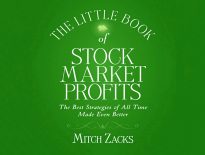Stock Market Profits 1 – Analysts and Small Caps

Today’s post is our first visit to a new book, The Little Book of Stock Market Profits by Mitch Zack.
Mitch Zacks
Mitch is a primary portfolio manager at Zacks Investment Management and all looks after investment research at the firm.
- He is an expert on quantitative investment strategies and has developed many proprietary models.
As well as the book, we are looking at, Mitch used to write a weekly finance column in the Chicago paper and has also written Ahead of the Market, which focuses on the earnings estimate revision anomaly.
Intro
Stock Market Profits looks at eleven market anomalies that can be expected to beat the market, in an attempt to:
Explain how to build long-term wealth in the equity markets.
Mitch says:
My book draws upon the survey of over 650 research papers published over the past 20 years [the book was published in 2011] that are summarized in The Handbook of Equity Market Anomalies.
Here’s a run-down of the eleven chapters:
- how to use analyst recommendations (not the way you might expect)
- small caps
- earnings estimate revisions
- price momentum (except when entering a recession)
- piggybacking on insider buys
- IPOs (bad) and stock buybacks (good)
- quality of earnings
- valuation measures
- post earnings announcement drift
- seasonal effects
- multi-factor models for growth stocks and value stocks
Mitch warns that:
An investor must be incredibly patient. Investment strategies which generate alpha have long periods of outperforming and underperforming the market.
Analyst recommendations
Mitch stresses that
It is very hard to predict the future. A stock may be a good buy due to various fundamental reasons, but this information is likely already in the price.
Mitch describes the role of a fictional analyst, Matt:
Matt is likely one of five or six people in the country who is an expert on the 10 enterprise software companies that he follows.
Matt’s reports contain:
- an estimate of what a company is going to earn on a per-share basis over the next two fiscal years;
- an estimate of how fast the company is expected to grow its earnings over the next five years;
- a buy/hold/sell recommendation;
- and a target price.
Note that Mitch’s firm is one of only a few that:
Track analyst recommendations and their performance in the marketplace.
Mitch says that the key is to:
Focus on recent recommendation changes from analysts with good track records in small-cap stocks.
The findings are:
- *Changes* in analysts’ recommendations can be used profitably, especially with smaller companies, and especially when used alongside other criteria.
- Transaction costs dramatically reduce the returns available.
- Some analysts have more impact than others, which means that ideally you need to research each analyst.
Mitch explains that until 1997, it was possible to follow analyst recommendations (buy and sell / short) and make money.
In contrast, a basket of stocks receiving upgrades has outperformed a basket of stocks receiving downgrades in 19 of the past 21 years.
- The more often you rebalance the portfolio (to add stocks with new changes in recommendations), the greater the outperformance.
Because the strategy doesn’t work every year, Mitch recommends sticking with it through an entire stock market cycle.
- Because of transaction costs, trading strategies also need to minimise turnover / frequency of transactions.
Smaller firms tend to be followed by fewer analysts, and the market for information about them is less efficient – which is probably why the strategy works best for them.
- It’s also possible that institutional investors are unwilling / unable to trade away the extra return on smaller stocks (because of higher trading costs, or fund restrictions, or necessary position sizes moving the market price).
Combination factors that work well with analyst recommendations (rather than with the more fleeting changes in recommendations) include:
- price momentum,
- cheap valuation multiples and
- high earnings quality.
These combination strategies also tend to have lower portfolio turnover.
Improving recommendations are linked with increasing prices (momentum) and increasing earnings.
- So as a group, analysts are not value investors – recommended stocks tend to be expensive compared to the market.
Mitch interprets this as meaning that the recommendation change anomaly may be driven by price momentum.
- Since pure momentum leads to high turnover, Mitch recommends the addition of some fundamental factor to recommendation-driven strategies.
Stock price increases can lead to both upgrades and downgrades.
- But stock price falls lead only to downgrades.
- Acting on these sell recommendations can help investors to counteract the behavioural bias that makes them hand on to stocks that have fallen in price.
The research also finds momentum / persistence in the effect that a single analysts reports produce (for at least two quarters).
- So following the “best” (most impactful) analysts will produce the greatest outperformance.
- This again could be explained by underlying price momentum.
Mitch points out that analysts who attended the same university as the company’s directors have bigger effects.
- But this research was carried out before the rules on sharing price-sensitive information were tightened up, so the effect may have disappeared.
Mitch also reports that individual investors focus on analyst upgrades (to buy), whilst institutional investors focus on downgrades (to sell).
- Mitch recommends that individuals also focus on sell signals (which are much rarer in any case).
Note that Mitch mentions seven countries in his analysis, but not specifically the UK.
Size
Small cap stocks outperform – everybody knows that.
- The smallest stocks do even better than the fairly small stocks.
Mitch defines small cap as under $2 bn market cap (large stocks are more than $10 bn market cap).
- In the UK, we could use the FTSE-350 for large caps and the Small Cap index for small caps.
This phenomenon was first documented way back in 1981, when the smallest quintile of stocks was found to outperform by 5% pa.
The problem was that right after being discovered, the anomaly disappeared for 20 years.
- Small stocks returned the same as large ones, with more risk (volatility).
Mitch is fully aware that Volatility is not Risk.
- Sophisticated investors look at the chance of a bad outcome, rather than volatility along the way.
He illustrates the problem with using volatility with a “picking up pennies in front of a steamroller” example.
- Situations with asymmetric returns, where the large downside is unlikely (black swans) can appear to be less risky than they really are (until the large negative downside occurs).
Mitch says that a lot of the small-cap outperformance in the US is due to the January Effect.
The theory is that small caps are mostly held by regular taxpayers, who sell them off at the end of the calendar year to generate losses or crystallise gains.
- That means prices are depressed in January, leading to outsize returns for buying then.
Mitch is not entirely convinced by this, but doesn’t rule it out.
Another possibility is that the excess returns are a reward for illiquidity.
- This makes sense to me – institutional investors can’t get involved with small caps, so information flow is lumpy, which leads to mispricings.
Mitch strictly means then when you come to sell a small cap, you need to find a buyer.
- So you might need to sell cheaply, producing a bargain for the guy on the other side of the trade.
He states further that the wide spread on small caps can entirely eliminate the excess returns from the anomaly.
- So we need to keep transactions to a minimum.
- But with transaction costs always falling, he expects the anomaly to work in the future.
Mitch also points out that the small-cap anomaly pairs well with value:
If you are going to try to exploit the small-cap anomaly, small-cap value is the way to go.
Conclusions
It’s been an interesting if somewhat low-key start to the book.
- I’ve focused on the actionable quirks of the market rather than Mitch’s explanations of why they might happen.
I’m not sure at this point how to receive timely notice of changes in analyst recommendations, but Stockopedia shows trends of analyst earnings forecasts in its Stock Reports, and they might work as a proxy.
- We’ll find out more at the end of the book when I try to build a stock screen or two.
The small cap phenomenon is well-known, but revisiting it has generated two (not original) ideas:
- Pairing small cap with value.
- A pairs trade between small cap and large cap to exploit the unreliability of the effect over time.
I’ll be back in a couple of weeks with the next three chapters of the book, which look at earnings estimate revisions, price momentum and piggybacking on insider buys.
Until next time.















